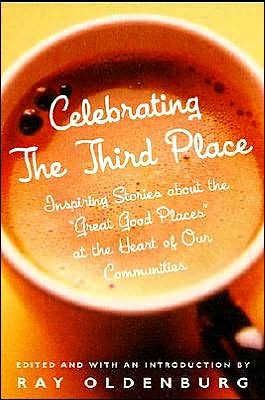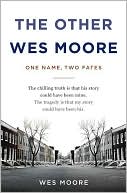Celebrating the Third Place: Inspiring Stories about the Great Good Places at the Heart of Our Communities
Nationwide, more and more entrepreneurs are committing themselves to creating and running "third places," also known as "great good places." In his landmark work, The Great Good Place, Ray Oldenburg identified, portrayed, and promoted those third places. Now, more than ten years after the original publication of that book, the time has come to celebrate the many third places that dot the American landscape and foster civic life. With 20 black-and-white photographs, Celebrating the Third Place...
Search in google:
Nationwide, more and more entrepreneurs are committing themselves to creating and running “third places,” also known as “great good places.” In his landmark work, The Great Good Place, Ray Oldenburg identified, portrayed, and promoted those third places. Now, more than ten years after the original publication of that book, the time has come to celebrate the many third places that dot the American landscape and foster civic life. With 20 black-and-white photographs, Celebrating the Third Place brings together fifteen firsthand accounts by proprietors of third places, as well as appreciations by fans who have made spending time at these hangouts a regular part of their lives. Among the establishments profiled are a shopping center in Seattle, a three-hundred-year-old tavern in Washington, D.C., a garden shop in Amherst, Massachusetts, a coffeehouse in Raleigh, North Carolina, a bookstore in Traverse City, Michigan, and a restaurant in San Francisco. Publishers Weekly Sociologist Oldenburg (The Great, Good Place) offers a compilation of essays on those places in America "where everybody knows your name." What Oldenburg calls "the third place" is different from home and work (the first and second places respectively) it's somewhere people can relax in good company on a regular basis. In this collection of 19 essays, proprietors and patrons of those third places describe how their establishments came into being and what exactly gives them their appeal. These third places aren't just diners and coffeehouses: there are establishments as disparate as Annie's Gift and Garden Shop, in Amherst, Mass., whose witty and provocative billboards provide a jumping-off point for conversation within the community, and Old St. George, an espresso bar located within a church's sacristy in Cleveland, Ohio. There's also the "great good gym" and, perhaps most surprising, an essay claiming prison to be the third place for many disadvantaged in American society. These charming and often thought-provoking essays, each written in a voice distinct as the place discussed, provide food for thought into the isolation our modern conveniences bring and people's need to come together as a community. This book will strike a comforting chord for those questioning the status quo and desiring to live a more authentic and connected way of life. (Jan.) Copyright 2001 Cahners Business Information.
\ \ \ \ Chapter One\ \ \ Annie's Gift and Garden Shop\ \ \ AMHERST, MASSACHUSETTS\ \ \ MOST THIRD places enjoy a location where pedestrian traffic is heavy and many regulars live but minutes away. Annie's, however, is located out in the rural countryside and the reader will learn how she cleverly lures people into her place and quickly convinces them that she is interested in much more than making money.\ Raised in a small tobacco town in the South, Annie was deeply influenced by a small restaurant that served as the local gathering place. It was one of those wonderful spots in which "everybody knows your name" and cares about you. That little restaurant, Fred's Place, embodied her dream of what to offer the public, even though her plant nursery differs sharply in both its offerings and location.\ Like Lynne Breaux, whose story also appears in this collection, Annie Cheatham is a woman steeped in the traditions of southern hospitality and determined to bring it north. She has succeeded famously.\ \ \ In the spring of my sophomore year at St. Mary's College, I got pneumonia. St. Mary's is a small Episcopal women's college in Raleigh, North Carolina, and in 1961 the infirmary occupied an old house on the campus. Two nurses staffed the facility, and I was the only patient. I was unhappy there, didn't get well, and after a week my parents took me home to the hospital. The doctor ordered glucoseand antibiotics, and as soon as I was well enough to eat solid food, my parents asked what I wanted. "A hot dog from Fred's," I said. That night the second floor hall of the Johnston County Memorial Hospital reeked of Fred Adams' chili sauce, and I was one meal closer to recovery.\ Fred's Place was a small restaurant on Third Street next door to Creech's Drugstore and Stallings' Jewelry in Smithfield, a rural tobacco town. Fred's was narrow and long, about fifteen by forty feet. It was poorly lit. A long bar stretched the length of the room. Small café tables lined the left wall. Fred worked alone behind the bar on the right.\ Fred served hot dogs, sodas in glass bottles, potato chips, and fried pork rinds. He only bought quality wieners and steamed the buns until they were spongy and soft. His mustard and relish were spicy, but the chili sauce was what made his hot dogs special. It had ground beef in it, chili pepper, and tomato sauce—common ingredients in any cookbook recipe. But it had something else, a secret from Fred, and I never found out what that was. It was the best chili I have ever eaten on a hot dog.\ Everybody ate at Fred's at one time or another. Lawyers in suits arguing cases at the county courthouse slipped into Fred's during the court's lunchtime recess. Tobacco farmers in stained overalls ate at Fred's. My father picked up a Fred's hot dog whenever Creech's called with a prescription or just before having his hair cut at the barbershop on the corner. In the hospital with pneumonia, I wanted a Fred's hot dog because Fred's meant home.\ Bernice's Beauty Parlor, Talton's Grocery, the Fashion Shop, and other public places in my hometown of four thousand also meant home. They not only provided services we needed, they also provided a sense of community. Adults in these places knew me and they cared about me, not in an overbearing or intrusive way, but enough so I noticed. I wasn't invisible. I had a name and people used it, sometimes to steer me back in the right direction. I've always been grateful for being known in that way. I liked the intimacy, and ever since then, I've looked for places that offer that kind of arm's-length caring. I rarely find it. When I started Annie's Garden and Gift Store, I was determined to create it.\ I had to face the differences. Annie's is not Fred's or Creech's, and Amherst, Massachusetts is not Smithfield. Annie's is not even located in a downtown. The store sits on a six-acre parcel on a major state road, Route 116, at the edge of Amherst township. Small agricultural enterprises surround it—a fish farm, organic vegetable farm, and another, part-time, farmer who raises a dozen cattle a year. Annie's uses two acres of the six; clover is planted on the rest and the cattle farmer cuts and bales it in June and October.\ It is no longer the late 1940s and 1950s and Annie's is not located in the rural South. Our customers are New Englanders, as friendly as southerners once you get to know them, but more reserved and reticent at first. They live in small communities scattered up and down the Connecticut River, each with its own town center. People are busier now than they were when I was growing up, and our customers don't have the leisure time that my parents' generation had.\ But Annie's did not emerge from a vacuum. And those early experiences in Smithfield informed me as I envisioned my new business. My business would be a place, like Fred's, where people would be known. That is what I remembered about my hometown; that is what I longed for myself. But it would be more than that. Because I am a teacher, it would be a place where people learned, became more competent and proficient. Because I am a student of religions and spirituality, it would be a place of beauty and rest, a sacred place in a busy world. Because I am a writer, it would be a place that plays with words. And because I believe in and practice organic gardening, it would be a place where a healthy connection between gardens and nature would be evident.\ Our first challenge was to attract customers and make sales. I opened in 1992 when the New England economy was deep in a recession. Businesses were closing, not opening; banks were calling in loans, not making them; and employees were leaving the area for the South and the West. But like every entrepreneur who's ever started a business, I was convinced that I had a good idea and that I could beat the odds and make it work. I knew organic gardening; I knew people loved gardening; I knew how to make beautiful places; and I guessed that others were just as hungry for places like Fred's as I was. Surely we could put together a combination that would succeed.\ Drivers on Route 116 were our most obvious market. The road is heavily traveled, but our building is not part of a strip mall. The only reason for anybody to stop at Annie's is because we have something they want. From the start we knew we would have to grab the drivers going by who were on their way to someplace else. We knew that we cared about them, wanted to know them, and that we had something special to offer them, but we had to get them in the door before they would know that.\ Every dime we had was going into restoring the dilapidated building and landscaping the grounds, but I knew that I'd have to spend money on a sign board with large changeable letters if we wanted to communicate with the drivers passing by. A few weeks before opening, we took the plunge, ordered an expensive set of letters and hung the board. We started by wrapping our messages around the sign—one phrase on the south side, the punch line on the north. "Only fourteen more days to open," we'd say on one side. On the other, "Honk if you think we'll make it." We kept this theme until we opened. "Ever start a business?/Come in and tell us how." "What's the secret to success?/Details, Details, Details." "Only five more days to open/Miracles do happen." "Grand Opening Today/Whew, We made it!" On opening day, smiling people came in to investigate, and we were in business.\ Since that day, our sign has taken on significance for members of our whole community. We respond to requests for birthdays, graduations, anniversaries, and memorials. We read local papers and congratulate award winners. These strangers may or may not be customers, may or may not drive down Route 116 that day. But someone will see the sign and call the honoree, and by day's end, a bunch of people will be out there taking pictures and posing.\ We use the sign to make fun of ourselves and our products. "Annie told me to change the sign/So I did." "Too hot, closed early/Gone swimming." "Trees marked to move/Help pay for our vacation." Faith Deering, a regular customer, recently recalled one of her favorite sign stories. "My son Dan and I were driving home one evening. Both of us were tired and cranky and neither of us was communicative. When we got to Annie's store, we both craned our necks to read the message, and it said, `Come in/Tell me what to have for supper.' Dan responds positively to calls for help and he loves cooking, so he immediately said, `Pull in, Mama, and I'll tell her what to cook!' After a good conversation with Annie, we left feeling far cheerier and full of ideas for our own family suppers. I have often wondered how many people's moods have been shifted or attitudes changed by a few words on that sign."\ We are also reflective and philosophical on our sign. "What is profit?/Top soil, leaf mold, compost." "Breathe/Keep breathing." "Do you have the answer?/What is the question?" And we play with the national news. After Monica Lewinsky turned in her stained blue dress and incriminated President Bill Clinton in a sex scandal, we put all blue flowers on sale. After a state of the union message, we wrote, "My fellow Americans/What is the state of your union?" During the Senate hearings and vote for Supreme Court Justice Clarence Thomas, we took a stand: "I believe Anita Hill."\ We tackle local news. In the spring of 1996, an adult pornography shop opened in a nearby town and the owner put a two-foot-wide banner across the front of his store saying, "Topless Coming Soon." He got a lot of media attention and offended many people, but nobody could stop him. We decided to have some fun with the story, and on our sign we wrote, "Topless birdbaths/Topless statuary" A local paper ran a story about our spoof; customers came in laughing, and bought a few things, the tops and bottoms of birdbaths.\ We communicate with drivers with other signs as well. A sign across our one-acre field reads, "Annie's Employees' Fitness Center," a spoof on other local businesses that build gymnasiums for desk-bound workers. And every November when darkness begins to lengthen on our New England days, we write "Light Comes" with lights on the side of our building to signify the coming of the solstice and the turning toward spring. We keep it lit until early March. Faith Deering reflected on what this sign meant to her when she first saw it. "In the early darkness of January evenings, `Light Comes' caught my eye. It was reassuring and hopeful, a beacon I looked forward to on my daily drive from Amherst to home. As the winter wore on, I became intrigued and wondered about the creator of the sign. The store was closed for the season"—We used to close for the winter months; now we are a year-round business—"so I left a message in the mailbox expressing the pleasure I got from the words."\ Annie's signs are community bulletin board, political soapbox, Zen center, pun-of-the-week poster, and awards banquet rolled into one. With them we nag, brag, love and adore, call names, point fingers, weep, and pray. In an age of information overload, our signs demonstrate an intelligence inside the business, a wit, a political and spiritual consciousness. "Somebody is thinking in there," our passersby might say.\ Once people come into Annie's, they quickly find that they are our first priority. We want to know our customers. We lean across the counter and ask about vacations and school activities, illness and recoveries, births and deaths. Because of our southern hospitality, our warmth and openness, our customers reveal themselves to us. One customer called the day she learned she had cancer to order an indoor fountain; another cried as she described a grave site where she wanted to plant bulbs; another came to tell us his first child had been born the night before; another to introduce us to his three sons on Father's Day. Paola Di Stefano explained how Annie's staff responds when she comes in. "I'm always greeted warmly and by name, and the staff's desire to help me and answer my questions goes way beyond what I'd expect of any store. They have loaned me tools, called me with information that I had requested, inquired about my garden, my health, a tool I'd bought several years earlier, and garden fantasies that I'd shared but never expected to put into practice. It feels as though they have a memory of me."\ Whenever you go to a place where people know and like you, you open yourself to others who are there. This happens at Annie's all the time. Customers run into people they know and pass information back and forth. Regular customers answer questions of new gardeners when our staff can't answer them. Often we see people exchanging phone numbers or business cards. For several years, Faith Deering, an entomologist, displayed an educational exhibit about monarch butterflies—five or six chrysalises in a jar and a flyer about the life cycle of monarchs. We all got caught up in the drama of the emergence, even the UPS deliveryman who checked the jar every day after he'd handed over our packages.\ Many of our customers feel a sense of ownership. One customer, Nancy Felker, volunteers to "fluff up our mulch" in the landscaping by the road. She loves this work, it makes the roadside display look fresh and tended, and passersby see what maintenance can do to liven their gardens. A group of women and men called Annie's Angels formed in the early years. They transplanted seedlings, loaded fertilizers for customers, swept the store, tilled the garden, cut flowers for bouquets. In exchange, they earned credits toward purchases, the equivalent of a 10 percent discount. For three years, twelve people blessed Annie's in this way, and one Angel, Beth Best, ended up working for us.\ We strive to make a place where people feel at home, and like Fred's, Annie's is modest and unpretentious. The store is thirty feet by forty feet with a shed roof and a six-foot overhang on the front. Built for a farm stand in the late 1970s, the structure had no central heating, and until I moved in 1991, no plumbing. Our two greenhouses are hoop structures covered with plastic sheeting, common among farms in the Pioneer Valley of western Massachusetts.\ We have made the most of this simplicity. Painted in warm, Italian colors—terra cotta oranges, light blues and greens, creamy yellows—our little shop invites rest. Every season we decorate our entrance differently—in winter with greens and wreaths, in spring and summer with flowers and vines, in fall with cornstalks and pumpkins. As you walk through our entrance, you see on your left a small water garden landscaped with local, mossy stone. We change the flower displays around the pond throughout the season to keep color there, and in December and through the long winter, we hang white lights on the trees and shrubs surrounding it.\ Once you are inside the store, you enjoy delightful and surprising niches and alcoves where Annie's artistic staff tuck treasures—bronze statues, tabletop fountains, dried flowers, and healthy houseplants in beautiful pots. And scattered around the property, in the store and in the greenhouses, are wooden and concrete benches and chairs for you to sit on to view gardens with perennials, ornamental grasses, giant reeds and vegetables, or plants in indoor water ponds.\ Annie's has become fuller over the years, a fact not missed by Ann Dorr, an accountant and regular customer. "Like gardens everywhere, Annie's is a work in progress," she said. "On opening day, all the features weren't up and in place. You landscaped the front one year, added the water-garden the next. That's what we do in our backyards. We cut another path; we wait a year until we can afford a piece of garden sculpture; we move things around. A garden evolves. Customers can relate to and be inspired by Annie's evolution."\ We pay attention to details and we show this by the creativity and beauty of our displays. We highlight the uniqueness of a product with lighting, placement, and with groupings. We mix textures and colors, heights and shapes. We also have an unusual mix of products from all over the world. Garden stores are often filled with functional items, tools for work. Annie's is filled with items that are functional, but because of the way we display' them, we imply that there is more to them than work. There is beauty, there is spirit, there is love of growing plants and being in nature. Julie Gross said, "It's hard to say what is so special about Annie's. It's always just so delightful, somehow, in a down-to-earth sort of way. I suppose there are plenty of people like me who delight in beauty but aren't so good at creating it for themselves. Annie's is ineffable, meaning inexpressible—too sacred to be spoken."\ Our customers sense our love of the natural world, and some of them come to Annie's as though to a wellspring. They sniff the dried lavender, they listen to the sounds of water dripping into a pond, they touch ash handles and forged steel tines on tools. They walk underneath arbors, around stone Celtic crosses and into greenhouses. When they leave us, they feel restored. Paola Di Stefano said, "I abandoned traditional religion at a young age, and I have found in the natural world the cycles of birth and death and rebirth that help me to understand myself, my community and the world around me. A visit to Annie's is like seeing these cycles through a magnifying glass. Sometimes I stop by just to feel refreshed, purified, and peaceful."\ Annie's replicates, then, some of the characteristics of Fred's and my hometown. We are unpretentious and warm, playful and upbeat. We know our customers and care about them. Still, what is Annie's secret chili recipe? What lures customers to Annie's when competitors like Agway and Wal-Mart are within five minutes' drive? Established independent garden centers are equally close, and specialty growers are ten minutes away. Just as you might ask, What's special about a Fred's hot dog, you might also ask, What's special about Annie's?\ Ray Oldenburg, in his book The Great Good Place, describes characteristics of places like Fred's and Annie's. They are on neutral ground, welcome all people, are accessible, modest, and playful. Customers develop a sense of ownership for the places, feel restored, at ease and rooted there, and regulars talk freely about their lives, their community, and the world. Great good places unite the community, serve the elderly, bring adults and children together in a relaxed setting, foster democracy, provide places for people to have fun. All of these qualities enhance and encourage friendship, understanding and tolerance.\ Even though Annie's demonstrates many of these characteristics, I knew we had to do more than know people, or to make them laugh when they drove by our store. I started asking myself, "What is it most of us need? What are we all longing for?" I did a mental survey of the people I know. Most are working hard and have too little time to relax. Most have enough money and are comfortable physically. But many are taking antidepressants or herbal stress remedies. Most complain that they don't have enough time to be with themselves, or with the people who mean the most to them. As I thought about these people in these situations, I wondered how Annie's might reduce the strains in their lives.\ To be in the gardening business is to be lucky, because, as Paola Di Stefano said, gardening connects you to the natural world. It brings you in touch with cycles and weather and problems you can't solve quickly or easily. When you plant a tree, you can't make it grow faster than it wants to grow. You have to be patient, wait and watch. It may take two or three seasons to amend acidic soil in a garden that's been neglected for a number of years. Gardening shows you the processes of nature that are slow and powerful. Ann Dorr said, "Gardening is a nurturing business. I don't think it is an accident that I drifted back to gardening after my special needs child went back to school. I was smart enough to know I needed to stay busy, (and gardening takes up all available time!), but gardening also fills up, to some degree, that nurturing void."\ Annie's is a business devoted to organic gardening. We have always promoted sustainable practices, low chemical use, and careful monitoring of plants and their health. How could we combine the spiritual aspects of gardening naturally with the spiritual longing in our customers? How could we develop our business into a place where our customers could rediscover themselves?\ Feeding people is one way to do this, and food is often served in great good places. You sit down, you stay awhile, and before you know it, you're talking with one of the regulars about the recent election or complaining about your job. Eating together brings people together. I had seen it happen at Fred's. I always wanted it to happen at Annie's. I was already producing Annie's Own line of jams and jellies, pickles and chutneys, and selling them from the store. From there I had no trouble envisioning people sitting at small café tables drinking tea and eating biscuits served with my orange marmalade. I could hear the chatter and the laughter that would come from such a scene, and I knew it would succeed.\ In 1993, we opened a tearoom at Annie's. We didn't have a kitchen, but we got a restaurant permit from the town, bought eight café tables and twenty chairs, and hung a sign. Our vision was to serve herbal teas made from organic herbs we grew in our garden. This would promote gardening, organic methods, and sustenance—all high values at Annie's. We bought scones and biscuits from a local bakery, opened the marmalade, made coffee and tea each morning, and for the next eighteen months, our customers had a place to eat.\ The tearoom never generated enough business to keep going, though the people who used it appreciated having a place to meet friends. Sales of our hard goods and plants were growing and we needed the retail space in our 1,200 square foot store. We slowly reduced the number of chairs and tables until none were left, took down the sign, put away the cups and saucers. The next question was, How can we feed people without giving them something to eat?\ There is real food, and there is spiritual food. At Annie's, we dole out the latter by giving away a poem with each sale. The idea came from my habit of sharing what I love, and I love poetry because it makes me slow down. I can't hurry and read a poem. If I do, I won't understand it, then I feel frustrated. I also love poetry because I love language, and poetry is word play at its peak.\ Since many poets write about gardening and nature in lyrical, humorous, accessible language, I started telling friends about poems, taking poems to dinner parties and reading them aloud, copying them down and mailing them to friends far away. One day I was telling a customer about a poem and I said, "I'll make you a copy and send it to you." And then I thought about giving poems away to everyone. Also I was looking for something to give the customer outside the exchange of money for merchandise. That exchange wasn't enough for me; it left me feeling empty. I wanted something I could hand over that was extra and free, something that would help the customer slow down and relax.\ (Continues...)\ \ \ Excerpted from Celebrating the Third Place by . Copyright © 2001 by Ray Oldenburg. Excerpted by permission. All rights reserved. No part of this excerpt may be reproduced or reprinted without permission in writing from the publisher. \ \ \ \
Introduction1Annie's Gift and Garden Shop9The Third Place Coffeehouse27Crossroads33Horizon Books43Old St. George55Square One Restaurant63El Taco Nazo73Tunnicliff's Tavern81Miami Passport Photo Shop91Good Neighbor Coffee House99Joe's Cozy Corner and Galatoire's107Civilization119The Great Good Gym131The Neutral Ground Coffee House143The Sharpest Irony155The Blue Moon Tavern169Plank's Cafe183Maxwell Street193The Coffee Beanery209Acknowledgments219About the Contributors221
\ Publishers Weekly - Publisher's Weekly\ Sociologist Oldenburg (The Great, Good Place) offers a compilation of essays on those places in America "where everybody knows your name." What Oldenburg calls "the third place" is different from home and work (the first and second places respectively) it's somewhere people can relax in good company on a regular basis. In this collection of 19 essays, proprietors and patrons of those third places describe how their establishments came into being and what exactly gives them their appeal. These third places aren't just diners and coffeehouses: there are establishments as disparate as Annie's Gift and Garden Shop, in Amherst, Mass., whose witty and provocative billboards provide a jumping-off point for conversation within the community, and Old St. George, an espresso bar located within a church's sacristy in Cleveland, Ohio. There's also the "great good gym" and, perhaps most surprising, an essay claiming prison to be the third place for many disadvantaged in American society. These charming and often thought-provoking essays, each written in a voice distinct as the place discussed, provide food for thought into the isolation our modern conveniences bring and people's need to come together as a community. This book will strike a comforting chord for those questioning the status quo and desiring to live a more authentic and connected way of life. (Jan.) Copyright 2001 Cahners Business Information.\ \ \ \ \ Publishers WeeklySociologist Oldenburg (The Great, Good Place) offers a compilation of essays on those places in America "where everybody knows your name." What Oldenburg calls "the third place" is different from home and work (the first and second places respectively) it's somewhere people can relax in good company on a regular basis. In this collection of 19 essays, proprietors and patrons of those third places describe how their establishments came into being and what exactly gives them their appeal. These third places aren't just diners and coffeehouses: there are establishments as disparate as Annie's Gift and Garden Shop, in Amherst, Mass., whose witty and provocative billboards provide a jumping-off point for conversation within the community, and Old St. George, an espresso bar located within a church's sacristy in Cleveland, Ohio. There's also the "great good gym" and, perhaps most surprising, an essay claiming prison to be the third place for many disadvantaged in American society. These charming and often thought-provoking essays, each written in a voice distinct as the place discussed, provide food for thought into the isolation our modern conveniences bring and people's need to come together as a community. This book will strike a comforting chord for those questioning the status quo and desiring to live a more authentic and connected way of life. (Jan.) Copyright 2001 Cahners Business Information.\ \








